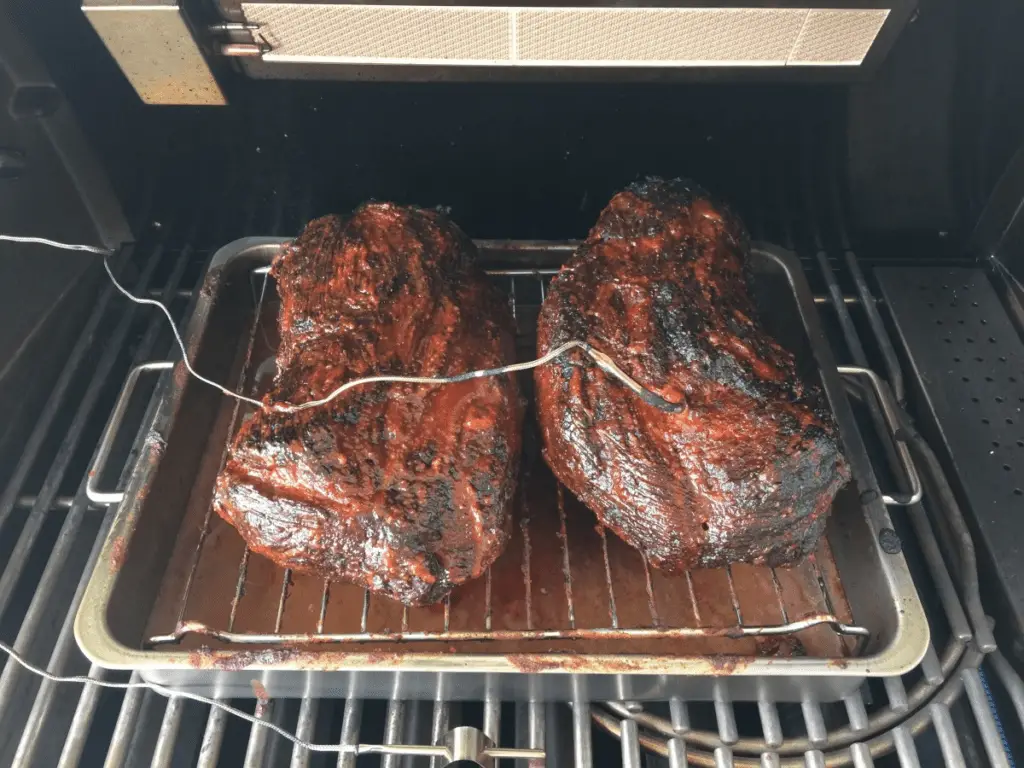Share via:
Cooking a perfect brisket is a labor of love that often spans 12 to 18 hours. But before you eagerly slice into your smoked brisket, there’s one crucial step you must not overlook: The Brisket Rest Time

Resting your brisket is the final touch in the cooking process, and it plays an important role.
Once you are past a brisket stall, you have to keep e keen check on “smoked brisket internal temp” to check its doneness.
Here, we reach the part where a high-temperature smoked brisket needs rest for its juices to redistribute and for the internal temp to come down to 145 F in a safe and proper way so that the brisket doesn’t become too tough or too cold for serving.
So How to rest a brisket? Or How long to let brisket rest?
Why Resting Brisket Matters
Brisket is a tough cut of beef and is composed of connective tissue that requires low and slow cooking to reach its full potential.
During the cooking process, the meat undergoes significant transformations. It contracts, connective tissues break down, and moisture is pushed outward. This is where the importance of resting comes into play.
When brisket rests, several essential processes occur:
1- Moisture Redistribution
Raw brisket contains approximately 71% water, which partially evaporates during cooking. When you cook brisket, the heat causes the juices to move towards the center of the meat. Resting allows the juices inside the brisket to redistribute evenly throughout the meat. Resting lets these juices flow back towards the edges and surface, helping to keep the brisket moist and flavorful.
Even after cooking, a well-cooked brisket still retains around 56% of its water content.
2- Collagen Conversion
Collagen, a tough protein found in brisket, begins to break down around 160°F. The extended resting period enables the collagen to gelatinize fully, resulting in a very tender texture of brisket.
3- Bark Enhancement
Resting also offers the opportunity to firm up the outer bark of the brisket. If your bark isn’t as crisp as you’d like, letting it rest with good airflow can help it achieve the desired consistency.
4- Flavor Development
When you let the brisket rest it allows the flavors to meld together. It gives the meat a chance to absorb and evenly distribute the spices, rubs, and smoky flavors developed during the cooking process, enhancing the overall taste.
5- Easier Slicing
Resting the brisket allows it to firm up slightly, making it easier to slice. Slicing too soon can cause the juices to run out, resulting in a dry brisket. Resting helps preserve those juices.
How Long to Rest Brisket
The ideal resting time for a brisket can vary depending on many factors, like the size of the brisket, the cooking method, and personal preferences. Here are some general guidelines:
- Minimum Resting Time: In most cases, you should rest a brisket for a minimum of 30 minutes. This allows the meat to relax, the juices to redistribute, and the temperature to stabilize. Resting for 30 minutes is often sufficient for smaller briskets.
- Average Resting Time: For an average-sized brisket (around 12-15 pounds), a resting period of 1 to 2 hours is commonly recommended. This brisket resting time provides a good balance between allowing the meat to rest and keeping it warm for serving.
- Extended Resting Time: Some people prefer to rest their briskets for even longer, up to 2 to 3 hours or more. This extended resting time can further enhance tenderness and flavor, as the meat continues to undergo changes during this period.
You can rest your brisket at room temperature for up to an hour, but anything beyond that raises food safety concerns.
How To Rest A Brisket – Different Resting Methods
Here’s how to rest a brisket:
1- Check the Internal Temperature
Before you even think about resting the brisket, ensure it has reached the desired internal temperature. Most pitmasters recommend an internal temperature of 195-205°F (90-96°C) for a well-cooked brisket. Use a reliable meat thermometer to check the temperature in the thickest part of the brisket.
2- Remove from the Heat Source
Once the brisket reaches the desired internal temperature, carefully remove it from the smoker or grill. Use heat-resistant gloves or meat claws to handle the hot brisket.
3- Wrap the Brisket
Wrapping the brisket is a common practice during the resting period. You can use either aluminum foil or pink butcher paper. The wrapping helps retain heat and moisture.
If using foil, wrap it tightly, ensuring there are no gaps or openings. If using butcher paper, wrap it snugly but not too tight, allowing some airflow.
Where To Rest A Brisket
To ensure safety and achieve perfection, here are some common methods for resting a brisket:
1- Resting Brisket At Room Temperature
If you’re in a hurry and need to shorten the brisket rest time, you can let your brisket rest at room temperature on a clean, dry surface, like a cutting board or countertop.
This method is suitable for resting brisket for up to an hour. Beyond that, there’s a risk of food safety issues if the internal temperature drops below 140°F (60°C).
2- Cooler or Insulated Container (The faux Cambro method):
This is one of the most popular methods for resting brisket. A well-insulated cooler, such as a Yeti or RTIC, can maintain a stable temperature for an extended period. Here’s how to do it:
- Wrap the rested brisket in a couple of towels to provide extra insulation and catch any drippings.
- Place the wrapped brisket inside the cooler and close the lid securely.
- The cooler will keep the brisket warm and moist for several hours, allowing for a flexible serving time.


If you lack a Cambro, a well-insulated cooler like a Yeti or RTIC can serve as a makeshift resting chamber. Wrapping the brisket in towels within the cooler offers extra insulation and catches drippings for easy cleanup.
3- Resting in a Cambro
A Cambro is a type of insulated food carrier that is commonly used in the catering and restaurant industry. It’s designed to keep food at a specific temperature.
A Cambro is available in both front-load and top-load models and is an excellent tool for resting brisket. These lightweight, food-safe containers come in various sizes and maintain temperature for extended periods. To use a Cambro for resting brisket:
- Place the rested brisket inside the Cambro.
- Close the Cambro’s lid tightly to maintain the desired temperature.
- Cambros come in various sizes and are excellent for holding multiple briskets or other barbecue meats.

4- Resting in a Steam Cabinet
Some barbecue restaurants and catering operations use steam cabinets to keep the meat warm and moist for extended periods.
Steam cabinets provide a heated space for food, and the steam helps prevent the meat from drying out. If you have access to a steam cabinet, it can be a great resting option.
How Long to Let Brisket Rest in Cooler?
Resting brisket in a cooler is a common practice for pitmasters who like cooking their meat early.
Many pitmasters swear that resting brisket for 12 hours is the best practice for the juiciest brisket. Resting brisket in butcher paper is also common, but many people finish it in the oven to retain the crispy bark of this delicious meat.
Why Rest Brisket in a Cooler?
- Countertop Resting: Allowing the brisket to rest on the countertop for a shorter period, typically around 30 minutes to an hour, is often done immediately after it comes off the smoker or grill. This initial rest helps the meat relax and the juices to redistribute somewhat. It’s a brief pause before you slice into the brisket.
- Cooler Resting (Holding):
Although brisket can be rested on the countertop for half an hour, however, resting brisket in the cooler for a longer time is essential both for retaining its juiciness and for effective time management when serving the meat later.
Cooler resting is a more extended resting period, typically lasting several hours, in a well-insulated cooler. During this time, the brisket continues to cook slightly due to carryover cooking, but more importantly, it allows for the collagen in the meat to further break down.
This process of resting brisket is called ‘holding’ the meat till the time it is ready to be sliced and served to your guests.
Rest vs. Hold:
Remember Step 1 is to let the brisket rest on counter top within a foil or paper and then when the internal temp goes down to 150-170, hold it in a cooler for several hours for carryover cooking depending on the size of the meat, your serving time and the internal temperature you started holding at.
If you put the meat for holding right away in the cooler, the temp will not come down and it will keep cooking and drying up more.
So resting on the countertop with foil or paper is an extremely important step after pulling it off the smoker at 205 F.
The downside of holding Brisket:
The only downside of holding brisket in a cooler is that it loses the crispiness of its bark due to the insulation within the cooler as well as the use of butcher paper.
How to Preserve the Bark’s Crispiness?
You can crisp up the bark before serving by placing the brisket back on a smoker or oven for less than 30 minutes.
It will help in getting rid of the sweat on the meat, re-heating it, and getting it crisp, all the while not letting it overcook.
Using the oven to hold the brisket
The oven can be used as a holding place as well for the hot brisket. It’s like a hot box that pitmasters around the globe use, especially in big restaurants.
Famous chefs pull a large number of briskets at 6 pm and hold them at 170 F for 17 hours till serving time the next day at 11 am.
It is recommended to use butcher paper, and a tray lined with baking paper for holding brisket at 170 F for four hours, which kept it nice and moist at 150 F internal temp.
Resting Brisket In Butcher Paper vs. Foil:
The choice between using foil or butcher paper for resting brisket depends on your desired outcome and how long you plan to hold the meat.
Foil is a complete insulator, trapping heat and moisture inside, which can result in a more tender and moist brisket. However, it can also make the bark slightly less crispy due to the retained moisture.
On the other hand, butcher paper is somewhat porous, allowing some moisture to escape and preserving the bark’s texture and flavor.
Bloggers and pitmasters often prefer resting brisket on butcher paper, particularly if they want to maintain a crispy bark.
Butcher paper allows the brisket’s internal temperature to come down more easily, making it a good option for shorter resting periods, such as 4 to 6 hours.
If you need to hold the brisket for an extended period, especially overnight, using butcher paper within a well-insulated cooler can effectively maintain the meat’s quality and temperature.
Another reason for that is that foil does not allow the brisket meat’s internal temp to come down very easily, even within 4 to 6 hours.
How Long to let Brisket Rest in Cooler?
It can depend on a number of factors, but BBQ Dropout’s channel on YouTube (I know…the name is too funny!) recommends resting brisket in cooler for at least 8 to 12 hours.
The meat comes off the smoker piping hot at 200 F approximately and all the moisture, collagens, and connective tissue need resting at that point.
Pulling it off the smoker and just slicing it right there and then will lose all that juiciness. He recommends resting till the temperature comes down to 165 F and all moisture is distributed and ready to slice through.
What If You Don’t Have An Insulated Cooler or Oven?
If you do not own an oven, you can use the Faux Cambro method for resting brisket in a cooler.
It’s basically meat wrapped in a towel within a food carrier. The temperature comes down slowly to 140 F if you insulate with a towel properly.
Or you can use butcher paper or foil instead for proper insulation. Preheat the cooler by pouring a tub of boiling water and closing the lid for a while.
Dump the water out place the brisket wrapped in foil and towel and pull at 200-205 F, within the cooler.
You allow the brisket to rest overnight wherein it reaches 140 F. The boiling water puts moisture into the carrier instead of taking it away from the brisket while keeping the latter moist.
Within an insulated cooler, you could skip the pre-heating step. As always, use a good probe and standard thermometer to monitor the internal temperature
Can Brisket Rrest too Long?
Yes, it is possible! Knowing all we know about resting, holding, slicing, and serving times.
It is essential that we rest the brisket before we hold it in a cooler even if it is for 12 hours to make sure the piping hot brisket does not keep on cooking and becoming dry in a cooler.
You can follow BBQ dropout’s method for quicker serving and for resting brisket for 12 hours for a brisket done too early. Follow the below-mentioned method.
How to Hold Brisket Overnight
What if the brisket is ready to pull but there is still half a day before it can be served? Let’s talk about resting brisket in cooler overnight.
Resting brisket for 12 hours is no easy feat. Monitoring the internal temp is your only saving grace in such a condition. Here is a step by step for that:
- Use a well-insulated cooler and place hot water in it about 30 minutes before the brisket is done.
- After resting it in foil and bringing the temp down to 170-180 F.
- Drain the cooler and place your wrapped brisket in foil within.
- Put a probe inside the meat with the wire out and close the cooler lid.
- Some bloggers swear by wrapping a moist towel around the wrapped brisket as well to make sure it keeps its moisture.
- Lastly, if you find the brisket is too soft. You can finish it on a smoker half an hour before you serve to make the bark crisp again.
- Remember, internal temp should always remain above 140 F.
More Brisket Tips
Best Brisket Serving Temp (SAFE TEMPERATURE TO SERVE & EAT BRISKET)
What Temp Does Brisket Stall? (STALL AT 125, 150, 175, 180,190)
Smoked Brisket Internal Temp (210°F or 225°F)
I am a writer, editor, and publisher of Grillcuisines.com – an online blog dedicated to sharing grilling tips, accessories, and recipes to encourage more people to get outside and grill.
I’m off to find out the different types of grill foods, their seasons, and how to conduct outdoor cooking properly. I’ll also show you some of my grill-worthy cooking tools & accessories!


